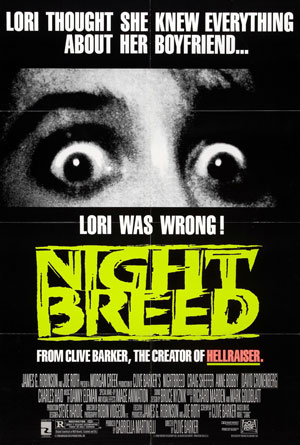 The story of Nightbreed’s production goes back to the pre-internet days reading fangoria magazine and conversations among those who were into horror movies and fiction. Clive Barker’s journey with this film started in the late ‘80s and continued into the early 2000s.
The story of Nightbreed’s production goes back to the pre-internet days reading fangoria magazine and conversations among those who were into horror movies and fiction. Clive Barker’s journey with this film started in the late ‘80s and continued into the early 2000s.
The story of this film is as relevant as the film itself. We have Clive Barker fresh off of Hellraiser working with a bigger budget, David Cronenberg himself as a central character, and a score composed by Danny Elfman. From the end of production, to the theatrical release and the “found’ cuts” that emerged more than a decade later, this movie teaches a lot about the production process. I’ve included some links to help you go down that road. For now, let’s take a look at the movie itself based on the version I recently watched: the 2014 Director’s Cut.
For additional information: http://www.clivebarker.info/nightbreed.html
Let's give this movie context for reflecting upon its odyssey and ultimately the presentation of the Director's Cut release. Basically the original is the theatrical cut and comes in somewhere around 100 minutes. There is what is called the Cabal Cut which is the theatrical version plus the working footage which totaled out to be something around 150 minutes. This circulated in the early 2000s. The Director's Cut was issued mid-2014 and is around 120 minutes with Clive Barker's approval (and is on Netflix). It is essentially the theatrical cut except that some of the scenes are replaced by versions of those scenes that Barker preferred (this totals out to something like a half-hour) plus some of the found working footage. (A thorough breakdown can be read here. Be sure to like movie-censorship on Facebook.)
The intro is fun and relevant. Good score track and some pertinent info. I really like the late ‘80s/early ‘90s intro style: long pan with centered credits and good music. The Batman (1989) intro is one of my favorite intro pieces and also features a Danny Elfman track. As a viewer you are kind of already in the plot from the start. The setting is important as the characters and the events. We follow our lead, Aaron Boone, amidst dealing with his psychological conflicts. This conflict ultimately drives his development and the characters around him. His initial plight helps introduce us to his psychiatrist (who leads us to police characters), and his love interest (who some contend is the heart of the film). The characters, all well established, create a mood with slightly odd dialogue styles.
The world, Midian, that lives alongside this contemporary world is also established early. The mysteries of its existence, however, are slowly revealed. Again, the exploration of Midian is a central reason for the existence of this movie. Plot is plot; it is a word defined. Where some movies are all plot-essential (and some will argue all movies must be plot-centralized), Nightbreed is introducing viewers to a world to be explored. As the film moves forward Aaron’s world collides with Midian and the story takes off from there. Paying close attention is paramount as we get bits of history about Midian as well as a better feel for the people. Nightbreed has moments of intense violence, and fans of the genre will surely have visual comparisons to other films. The special effects and makeup bring Midian to life vividly and keeps the viewer further interested in the movie.
Elfman brings a visually-inspired approach that (more recently) Hans Zimmer took for the Batman trilogy, an approach that framed Nightbreed similarly in the way Carpenter’s scores help frame his own films. This world, Midian, and these circumstances are somehow slightly recognizable and grounded. To Elfman’s credit his score, along with key allegories in the film, keep Nightbreed eerily comparable to our own world.
Barker exudes care for his work and an affection for the worlds/characters he creates. This endearing quality elicits a very real feeling for fans. Nightbreed’s spirit will live on thanks to tireless work that occurred over nearly two decades. An essential element of art, and the creation of art, is endurance. Fans and supporters wanted to give to Barker what he tried to give to all of us: a complete film adaptation as he intended. No one gave up on this film and that approach is something we can all take with us as we tackle our own endeavors. Thank you to Mr. Clive Barker and everyone who worked to bring this picture to life.








